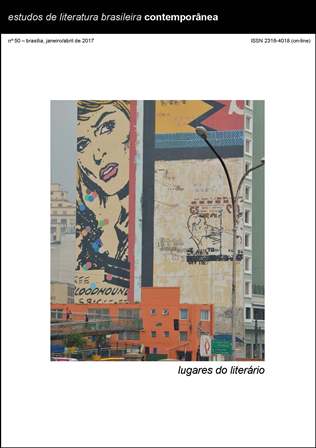Outros retratos, outras vozes na narrativa brasileira contemporânea
DOI:
https://doi.org/10.1590/2316-40185016Abstract
Neste artigo abordo a questão da emergência de novas vozes socias, antes excluídas das representações artístico-literárias nacionais, que assomam com ímpeto e querem contar no panorama da literatura brasileira contemporânea. Entre essas vozes, que têm como precursora Carolina Maria de Jesus, focalizarei brevemente a obra de Ferréz.
References
COSTA, Wilma (2014). Aos que ainda sonham. Rascunho, Curitiba, n. 167, p. 15, mar. Disponível em: https://goo.gl/Jkdj7m. Acesso em: 8 jul. 2014.
CRUZ, Adélcio de Souza (2009). Narrativas contemporâneas da violência: Fernando Bonassi, Paulo Lins e Ferréz. Tese (Doutorado em Letras) ”“ Universidade Federal de Minas Gerais, Belo Horizonte. Disponível em: https://goo.gl/T1eBil. Acesso em: 8 jun. 2013.
DALCASTAGNÈ, Regina (2005). A personagem do romance brasileiro contemporâneo: 1990-2004. Estudos de Literatura Brasileira Contemporânea, Brasília, n. 26, p. 13-71, jul./dez.
DALCASTAGNÈ, Regina (2012). Literatura brasileira contemporânea: um território contestado. Vinhedo: Horizonte; Rio de Janeiro: Editora da Universidade do Estado do Rio de Janeiro.
FERRÉZ (2013). Ferréz é o entrevistado do Provocações. TV Brasil. On-line. Disponível em: https://goo.gl/1lB2Wx. Acesso em: 24 jun. 2014.
FERRÉZ (2000). A revolução tem de ser feita, pela arte ou pelo terror. Folha de S. Paulo, São Paulo, 22 jul. Disponível em: https://goo.gl/nK8Rqu. Acesso em: 8 jul. 2014.
FERRÉZ (2001). Mesa-redonda Linguagens da violência, violência da linguagem. In: CICLO CULTURA E SOCIEDADE: as linguagens da violência. São Paulo, 13 set. SESC, UNESCO e Consulado Geral da França de São Paulo. Disponível em: https://goo.gl/YlOZ1S. Acesso em: 30 jan. 2013.
FERRÉZ (2003) Manual prático do ódio. Rio de Janeiro: Objetiva.
FERRÉZ (2005a). Terrorismo literário. In: FERRÉZ (Org.). Literatura marginal: talentos da escrita periférica. Rio de Janeiro: Agir. Disponível em: https://goo.gl/lVWvqG. Acesso em: 25 maio 2013.
FERRÉZ (2005b) Capão Pecado. Rio de Janeiro: Objetiva.
FERRÉZ (2006). Ninguém é inocente em São Paulo. Rio de Janeiro: Objetiva.
FERRÉZ (2007). Pensamentos de um correria. Folha de S. Paulo, 8 out., Seção Tendências/ Debates. Disponível em: https://goo.gl/9PIvLm. Acesso em: 24 jun. 2013.
FERRÉZ (2012). Deus foi almoçar. São Paulo: Planeta.
FERRÉZ (s.d.). Blog do autor. On-line. Disponível em: http://ferrez.blogspot.com.br/. Acesso em: 24 jun. 2014.
FISCHER, Luís Augusto (2008). Literatura brasileira: modos de usar. Porto Alegre: L&PM.
GINZBURG, Jaime (2012). O narrador na literatura brasileira contemporânea. Tintas. Quaderni di letterature iberiche e iberoamericane, Milano, n. 2, p. 199-221. Disponível em: https://goo.gl/DIrBUP. Acesso em: 20 jul. 2015.
HUCK, Luciano (2007). Pensamentos quase póstumos. Folha de S. Paulo, Seção Tendências/Debates. 1º out. On-line. Disponível em: https://goo.gl/SZP1qa. Acesso em: 2 maio 2013.
OLIVEIRA, Nelson de et al. (2007a) Cenas da favela: antologia. Rio de Janeiro: Geração.
OLIVEIRA, Rejane Pivetta de (2011). Literatura marginal: questionamentos à teoria literária. Ipotesi, Juiz de Fora, v. 15, n. 2, p. 31-39, jul./dez.
PELLEGRINI, Tânia (2001). A ficção brasileira hoje: os caminhos da cidade. Revista de Crítica Literária Latinoamericana, Lima-Hanover, ano 27, n. 53, p. 115-118.
PELLEGRINI, Tânia (2004). No fio da navalha: literatura e violência no Brasil de hoje. Estudos de Literatura Brasileira Contemporânea, Brasília, n. 24, p. 15-34, jul./dez.
ROCHA, João César de Castro. (2007). Desafio ao malandro. Época, São Paulo, n. 487, 17 set. Disponível em: https://goo.gl/w9ywBH. Acesso em: 12 out. 2013.
Downloads
Published
Issue
Section
License
Authors who publish in this journal agree to the following terms:
a) The authors maintain the copyright and grant the journal the right of first publication, the work being simultaneously licensed under the Creative Commons Attribution License-Non Commercial 4.0 which allows the sharing of the work with acknowledgment of the authorship of the work and publication this journal.
b) Authors are authorized to enter into additional contracts separately, for non-exclusive distribution of the version of the work published in this journal (eg publish in institutional repository or as a book chapter), with authorship recognition and publication in this journal.
c) Authors are allowed and encouraged to publish and distribute their work online (eg in institutional repositories or on their personal page) after the editorial process, as this can generate productive changes, as well as increase the impact and citation of published work (See The Effect of Free Access).
d) The authors of the approved works authorize the magazine to, after publication, transfer its content for reproduction in content crawlers, virtual libraries and the like.
e) The authors assume that the texts submitted to the publication are of their original creation, being fully responsible for their content in the event of possible opposition by third parties.


